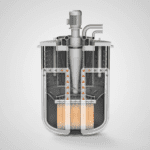The Wylfa Nuclear Power Station—the last operating Magnox reactor in the world—came offline permanently on Dec. 30.
Located in Anglesey, an island off the northwest coast of Wales in the UK, the plant entered service in 1971. Originally constructed with two 490-MW units, only Reactor 1 has been operating since 2012.
The UK pioneered the Magnox design back in the 1950s. Its name comes from the magnesium-aluminum alloy used to clad the fuel rods. The reactors were pressurized, CO2-cooled, graphite-moderated units fueled with natural uranium. The design could also be used to produce plutonium for nuclear weapons. The first of 11 eventual plants was the 190-MW Calder Hall facility in Cumbria, which opened in 1956. The Wylfa site was the largest of the Magnox plants.
“Today marks a safe and dignified end to the generation of electricity at Wylfa, and indeed for Magnox, and I am proud to say that I was a part of it,” said Stuart Law, Wylfa’s site director.
Reactor 1 actually outlived its expected life. The plant was originally due to close in 2010 because the manufacture of Magnox fuel ceased in 2008, but regulators endorsed an Inter-Reactor Fuel Transfer (IRX) process, which allowed Reactor 1 to remain in service until now.
Fuel in the reactors normally required replacement with new fuel after about five years, with the old (spent) fuel sent to Sellafield for reprocessing. Because this was a continuous process, at any point in time the age (irradiation) of the fuel in the reactor ranged from new through to fully irradiated requiring replacement.
Following the permanent shutdown of Reactor 2 on April 25, 2012, there was a substantial amount of useable fuel remaining in that reactor. Therefore, instead of shutting down Reactor 1 when new fuel supplies ran out, the IRX process allowed the newer (low-irradiation) fuel that remained in Reactor 2 to be transferred into Reactor 1, enabling continued operation.
“I am proud of the team’s innovative work, which made this extended operational life possible, but the time has come to finally switch her off and move into the decommissioning phase,” said John Clarke, chief executive of the Nuclear Decommissioning Authority, the group responsible for managing the cleanup of the UK’s nuclear legacy, implementing government policy on higher-activity radioactive waste, and executing the country’s low-level waste strategy.
Fuel rods are already being removed from Reactor 2 and dispatched to Sellafield for reprocessing. Defueling of Reactor 1 is expected to begin during early summer 2016, with a target for the site to be fuel free by late 2018. Full-scale decommissioning will take several decades.
History buffs interested in taking a step back in time to 1965 to witness construction activities at the Wylfa site can view the video footage below.
—Aaron Larson, associate editor (@AaronL_Power, @POWERmagazine)










